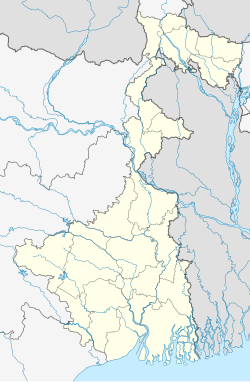Chamta is a village in the Tufanganj I CD block in the Tufanganj subdivision of the Cooch Behar district in West Bengal, India
Chamta | |
|---|---|
Village | |
| Coordinates: 26°18′27″N 89°39′14″E / 26.3075°N 89.6539°E | |
| Country | |
| State | West Bengal |
| District | Cooch Behar |
| Population (2011) | |
| • Total | 8,190 |
| Time zone | UTC+5:30 (IST) |
| PIN | 736159 |
| Telephone/STD code | 03582 |
| Vehicle registration | WB |
| Lok Sabha constituency | Alipurduars |
| Vidhan Sabha constituency | Tufanganj |
| Website | coochbehar |
Geography
edit5miles
temple
Pratham
Khanda
CT: census town, M: municipal town, R: rural/ urban centre, H: historical/ religious centre
Owing to space constraints in the small map, the actual locations in a larger map may vary slightly
Location
editChamta is located at 26°18′27″N 89°39′14″E / 26.3075°N 89.65399°E.
Area overview
editThe map alongside shows the eastern part of the district. In Tufanganj subdivision 6.97% of the population lives in the urban areas and 93.02% lives in the rural areas. In Dinhata subdivision 5.98% of the population lives in the urban areas and 94.02% lives in the urban areas.[1] The entire district forms the flat alluvial flood plains of mighty rivers.[2]
Note: The map alongside presents some of the notable locations in the subdivisions. All places marked in the map are linked in the larger full screen map.
Demographics
editAs per the 2011 Census of India, Chamta had a total population of 8,190. There were 4,240 (52%) males and 3,950 (48%) females. There were 885 persons in the age range of 0 to 6 years. The total number of literate people in Chamta was 5,529 (75.69% of the population over 6 years).[3]
Culture
editThere is a small temple with char-chala tin roof, wherein a triangular stone covered with vermillion is worshipped as Devi Ghurneswari, a form of goddess Kali. A trishula representing Bhairava is also worshipped. The temple draws devotees in large numbers on festive occasions. According to local legend, a cow/ buffalo used to come regularly and offer milk to the stone-piece lying under a banyan tree. Information about the incident reached Maharaja Harendra Narayan (1780-1839) of Cooch Behar State. He had a temple built, but the present one seems to be a later construction.[4]
References
edit- ^ "District Statistical Handbook 2013 Cooch Behar". Tables 2.2, 2.4b. Department of Planning and Statistics, Government of West Bengal. Archived from the original on 21 January 2019. Retrieved 5 August 2020.
- ^ "District Census Handbook, Koch Bihar, Series 20, Part XIIA" (PDF). Census of India 2011, pages 17-21 Physical feafures. Directorate of Census Operations, West Bengal. Retrieved 5 August 2020.
- ^ "C.D. Block Wise Primary Abstract Data(PCA)". West Bengal – District-wise CD Blocks. Registrar General and Census Commissioner, India. Retrieved 3 August 2020.
- ^ Koch Bihar Jelar Purakirti (in Bengali), Data compilation and writing by Dr. Shyamachand Mukhopadhayay, published by the Department of Archaeology, Government of West Bengal, Second edition 1974, Pages 47-48.

